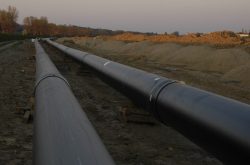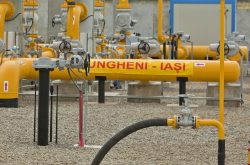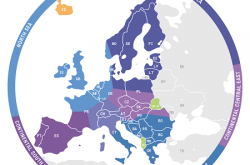Overview
Source: elp.com
The rapid growth of renewable generation and the significance of long-term planning.
Rapid penetration of renewables is dramatically changing the energy landscape in the United States. Decreases in production costs, federal tax incentives, state renewable portfolio standards, and the Environmental Protection Agency’s Clean Power Plan are some of the main drivers for rapid renewable development. To support these policies, additional transmission capacity will need to be built to transmit energy from remote areas where the renewable generators are located to major load centers.
As illustrated in Figure 1, the next decade has a large number of proposed projects to modernize the North American transmission infrastructure. Almost 900 different lines and nearly 42,000 miles of infrastructure projects are proposed in North America in this time period. The Edison Electric Institute indicates that around $48 billion worth of transmission investments are expected between 2015 and 2025¹. Of this total, projects supporting
the integration of renewable resources represent approximately $22 billion (46%). This endeavor will require careful planning and coordination of new power generation and transmission projects, as the scope and construction span of each project can be quite different and complex. In fact, given the diversity and complexity of various transmission and renewable generation projects, data analytics has become one of the most vital steps for a sophisticated project development process.

Figure 1: Proposed transmission infrastructure projects in the next decade²
The timing gap between generation and transmission investments.
Location and timing are two critical elements of transmission and generation investments. Rapid growth in renewable capacity is not always accompanied with rapid transmission expansions. For example, a significant overbuild of renewables before the completion of transmission lines occurred between 2007 and 2011 in West Texas.
Figure 2 illustrates the total wind generation capacity in West Texas and total transmission capacity from West Texas to other areas between 2002 and 2015. The figure shows that wind generation capacity in West Texas increased by around 6,400 MW between 2007 and 2011, while there was no significant transmission capacity addition in the same period. Therefore, transmission capacity between West Texas and major load centers in Texas was notably insufficient to bring all the electricity to these areas.

Figure 2: Total wind generation and transmission export capacity in West Texas³
This transmission capacity discrepancy caused real-time operational difficulties, congestion and reliability issues in the Electric Reliability Council of Texas (ERCOT) footprint. As shown in Figure 3, ERCOT had to occasionally curtail wind generation to keep the transmission network within its physical limits in 2011 and 2012. These curtailments, demand-supply imbalances in the West and negative market bids by the wind generators occasionally produced negative real-time prices in these years.

Figure 3: Wind generation curtailments and negative real-time electricity prices in ERCOT West hub4
Figure 3 also shows that wind generation curtailments and negative real-time prices in ERCOT have steadily dropped after 2012. This was because over 3,500 miles of transmission lines, representing 168 projects, had been completed between 2008 and 2013 (mostly in 2012 and 2013) thanks to the Texas Public Utility Commission (PUC) Competitive Renewable Energy Zones program. Major transmission capacity additions took place in 2014 and 2015, which further helped minimize the congestion issues.
The fundamental issues.
Can we close this timing gap completely? The short answer is no, but regulators can better coordinate the proposed generation and transmission investments to minimize the timing gap. The fundamental issue results from the deregulation of the power industry, where transmission and generation owners can be completely different companies. Coordination between generation and transmission projects is never perfect, because these projects have different owners, scopes, capital structures and construction durations. In addition, these projects are regulated by different state and local entities and have to go through various permitting procedures.
Efforts to better coordinate the proposed projects are hindered by the differences in the scope of regulatory authorities of PUCs and independent system operators (ISOs), as well as other regulatory entities. The regulatory scope differences can often lead to the use of different data and methodologies in long-term regional planning studies. One can argue
that PUCs and ISOs already cooperate in their long-term planning efforts fairly well; however, given the rapid growth of renewables, PUCs and ISOs will need to cooperate seamlessly
to minimize the potential negative impacts on the power grid. This can be simpler in a state like Texas where the ISO serves only one state; however, political factors make it more complicated in other ISO footprints where several states are under the umbrella of one ISO.
Improved IT structure to increase synergy between regulatory entities.
Regulatory entities can create more coordinated “joint task forces” and utilize a common database as well as use the same software solution in long-term planning studies. Seamless cooperation between regulatory entities may sound too idealistic, but it is possible. The era of big data and cloud services is here; examples include Microsoft® Azure, which can provide rapid and secure access to a common database, and hosted software solutions such as ABB’s integrated energy solution, e7. This will immensely improve the cooperation and synergy between the regulatory entities. Such improvements in IT structure are likely to shorten the bureaucratic process for proposed investment approvals.
The role of planning software solutions.
As mentioned above, using common planning software solutions can improve the communication and synergy between regulators overseeing the projects. Choosing the right software solution is one of the critical components of the long-term resource adequacy and transmission studies. ABB Capacity Expansion software can produce multi-year horizon resource plans to meet long-term resource reliability requirements. These generation plans can then be integrated into ABB PROMOD, a solution that incorporates extensive details in transmission grid topology and constraints, and creates economic transmission plans.
A green and bright future.
There is a clear trend in the power industry: There will be significantly more renewable capacity coming online in the next decade. Better cooperation between regulatory entities and more efficient long-term plans are needed to coordinate future generation and transmission investments. This will help ensure successful integration of renewables to the power grid while increasing real-time reliability of the grid and economic efficiency of generation and transmission investments. Software solutions and cloud services will play a key role in this integration process.
Want to know more about ABB Energy Portfolio Management solutions?
¹ Edison Electric Institute (2015, March). Transmission projects: At a glance. Retrieved from http://www.eei.org/issuesandpolicy/transmission/pages/transmissionprojectsat.aspx
² ABB Velocity Suite (2016, April).
³ ABB North American Power Reference Case (2016, April)
4 U.S. Energy Information Administration (2014, June 24). Fewer wind curtailments and negative power prices seen in Texas after major grid expansion. Retrieved from http://www.eia.gov/todayinenergy/detail.cfm?id=16831
Authors
Carlos A. Romero, VP – Energy Portfolio Management (EPM), ABB
Erdal Kara, Industry Solutions Executive, ABB
About the Enterprise Software Product Group within ABB
We provide industry leading software and deep domain expertise to help the world’s most asset intensive industries such as energy, transportation, utilities and mining solve their biggest challenges, from plant level, to regional network scale, to global fleet-wide operations. Our enterprise software portfolio offers an unparalleled range of solutions for asset performance management, operations and workforce management, network control and energy portfolio management to help customers reach new levels of efficiency, reliability, safety and sustainability. We are constantly researching and incorporating the latest technology innovations in areas such as mobility, analytics and cloud computing. We provide unmatched capabilities to integrate information technologies (IT) and operational technologies (OT) to provide complete solutions to our customers’ business problems.
www.abb.com/enterprise-software
Image courtesy of dan at FreeDigitalPhotos.net
Map
Visited 7413 times, 1 Visit today








